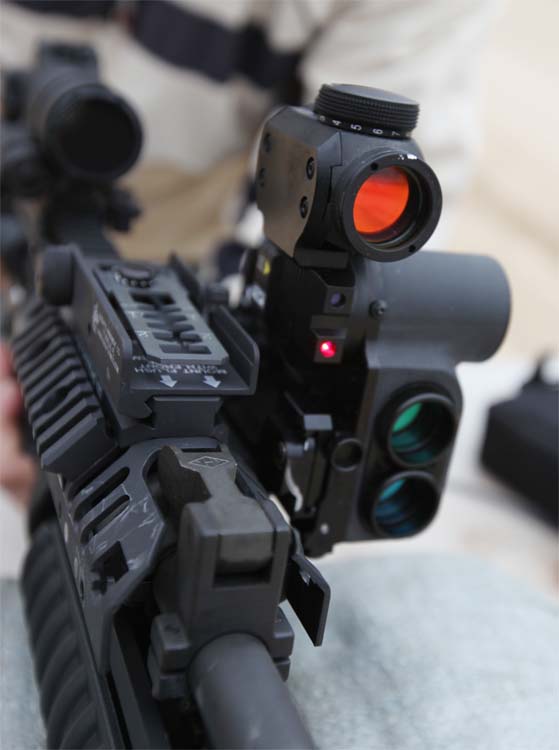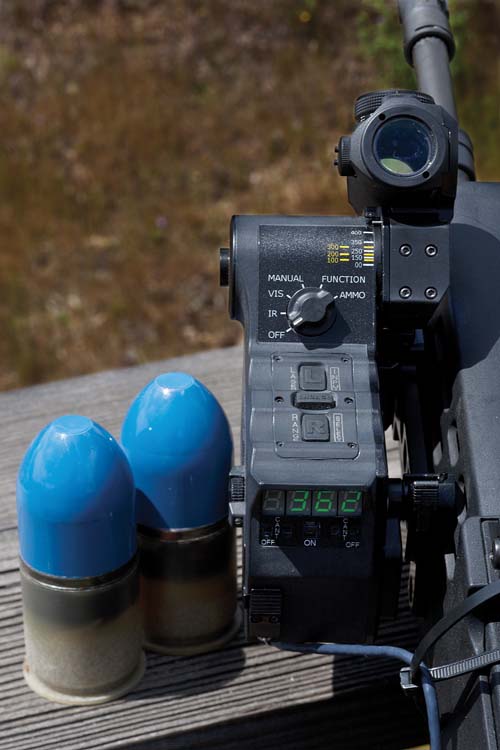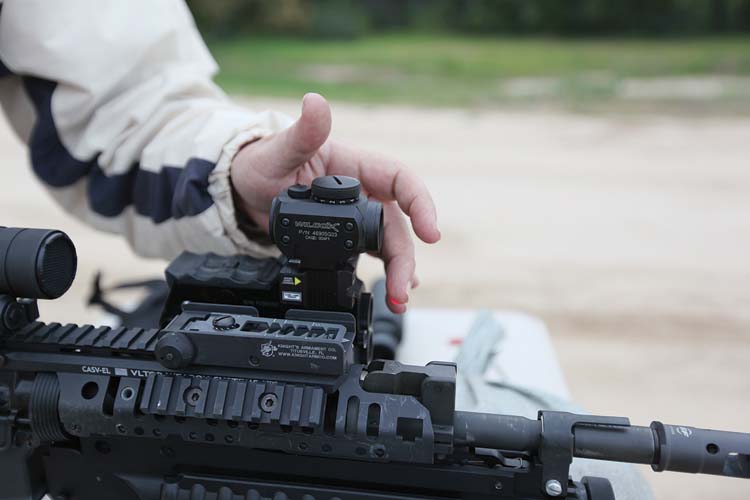
An electro-optical sighting device for the M203 grenade launcher sets a whole new definition of “close enough” for grenades.
Resisting the urge to make bad puns about grenades and their attendant proximity capacities, we have before us a problem. Using only an M203, how can we place a fragmentation round in the middle of a band of bad guys on a moonless night, hidden behind rocky outcroppings, uphill at 300 meters? Oh yes – and make it a first-round hit.
Even the most experienced grenadier has trouble shooting a 203 at night. Assuming he can see a crouching, ducking, scampering target, distance is much harder to judge in darkness and ladder sights are not illuminated. A tough problem. And then there’s factoring in an angle of inclination for an uphill shot. A first round hit? At night? Uphill? Fat chance.

Unless, that is, the 203 is equipped with a Rapid Acquisition Aiming Module (RAAM) from Wilcox Industries. The RAAM is a day-night sight specifically addressing the problems of the 203 with its low-velocity, high-trajectory munitions. The RAAM incorporates a sophisticated range finder which feeds data to a processor that automatically calibrates the system for a selected munitions’ trajectory, setting in motion a motorized gimbal mounted with an Aimpoint Micro T1 sight. Put the red dot on the target and fire.
For night-time targets, the grenadier can either use his NODs with an IR setting on the Aimpoint or use the RAAM’s built-in IR laser. The motorized gimbal also positions the IR laser for the correct trajectory. In testing with the Navy SEALs based in Coronado, Calif., first-round hits at night on unknown distance targets were boringly routine.
The RAAM is almost an oxymoron: “high tech” and “grenade” not usually appearing in the same sentence. However, the device is no contradiction of terms; it solves a very real and persistent problem with good old fashioned Yankee engineering.
The Wilcox Connection
Wilcox Industries developed the RAAM in a teaming project with Swiss manufacturer Vectronix, best known for their state-of-the-art range finding technology. The RAAM is currently being fielded by the UK MOD (Ministry of Defense) and testing is proceeding apace with select elements of SOCOM in this country.
Wilcox Industries is not (yet) a household name, but the New Hampshire-based company is very much a player in a variety of high-tech products for military small arms as well as related products. Company founder and CEO Jim Teetzel describes Wilcox as a “skunk works for the Special Forces” with a unique engineering and manufacturing capability to pretty much build anything.
That’s a broad claim, but a brief scan of the company’s website (www.wilcoxind.com) reveals they manufacture several categories of products: night vision mounts (more on that later); small arms systems and support products; chem-bio breathing apparatus; weapon mounts; aerial support products; and that wonderfully mysterious catch-all, “special projects.”
Wilcox developed the RAAM in response to a call from certain military units that prefer not to be named. The goal was simple: first round hits with any suitable munition at night, uphill, downhill, on the level, doesn’t matter. The stated requirement for a “hit” was an impact within five meters of a target at 300 meters, which corresponds to the kill radius of 203 frag and HE munitions.
RAAM Operation
Looking at the RAAM, you’re greeted with an 8-position “mode selection” knob, three rubber-covered buttons and a small LCD display. It sounds more complicated than it is. Once you make a couple of basic decisions, it’s fire and forget.

The most complicated setting on the main control knob is labeled Function. This is similar to a digital camera or smart phone in that once you set the “functions,” you don’t need to revisit them. Here are the settings:
- Disp: for the LCD display: day mode, night mode or automatic (using a photo sensitive cell); sets the brightness of the display.
- Tact: factory test function, not for the operator.
- Star: stands for Single Target Auto Rotate in which the gimbal adjusts automatically as soon as the range finder gets a good reading (instead of separately pressing an Engage button to move the gimbal)
- Range: a built-in safety, factory set at 40 meters, the RAAM won’t function if the range finder shows the target is closer than this number.
- Suer: software version, not for the operator.
- Buer: shows what ballistics are loaded, not for the operator
- Test: verifies the unit is working by cycling through a programmed series of tests of all functions; if Test blinks, it’s self-diagnosed as good to go.
- Cant: turns on and off the cant indicators; cant indicators let the grenadier know if he’s canting his 203
- Lite: manually sets the brightness of the display
- Bat: shows the remaining battery life (operates on two CR-123A lithium batteries)
- Dflt: factory default settings

Having dispensed with the basic function settings (trust me, just leave them on factory defaults), you need to set the RAAM for the munition you’re using. Dial the switch to “ammo” and select from the memory of programmed trajectories, most likely a chalk practice round or, in combat, HE or frag.
Second, decide if you want night or day lasers, infrared or visible. Four of the eight switch settings control the RAAM’s lasers (plural): IR Low, Vis Low, IR High and Vis High. These refer to targeting lasers. The ranging laser (separate) is always IR. Bear in mind that when set on High, the emitted laser is not eye-safe (10 milliwatts, up to 25 on special order). The visible laser is primarily used for bore sighting the RAAM during installation on an M203-equipped rifle, however, in certain lighting conditions, it can be used to sight the target.
The next step in operating a RAAM is to lase the target for distance. Because of the low-velocity, high-trajectory nature of a 203’s munition – you can leisurely watch a round in flight, so lethargic is its lazy arc – the biggest problem for a grenadier is accurately judging distance. A goof of only 25 yards in distance estimation is a clean miss with a first shot. The RAAM removes distance judgment from the equation. You range the target by pressing the bottom-most button on the RAAM unit, the one with a big R, or using a remote switch you’ve Velcroed to your 203.
Functioning with a 1,550 nanometer IR laser (invisible even with night vision), the range finder determines distance and feeds the data to the RAAM’s ballistic computer. The RAAM’s temperature sensor has simultaneously entered the ambient temperature into the computer. If the target is inclined or declined, an accelerometer in the RAAM adds the target’s angle and the ballistic computer gives a firing solution. (There is no provision for altitude because a 203’s munitions are unaffected up to 10,000 feet.) You have two options at this stage: you could have programmed the RAAM to automatically move the gimbal as soon as the range is detected and the computer has derived a solution (instantaneous) or you can manually press the center button on the RAAM marked Engage (or a similar button on a wire-tethered remote switch).
The gimbal now rotates. Again, you have options. You can use the Aimpoint Micro (best for day-time) or the 850 nanometer IR laser for night-time. As an interesting aside, grenadiers score better with the RAAM at night using NODs with the IR laser than in the day with the Aimpoint.
Shooting the RAAM
The RAAM attaches either to a 203’s tube directly or (better) to an M1913 rail forend. Either mounts are available, but the rail-mount is stronger and easier to remove or install. When a RAAM is first mounted, it must be bore sighted to the 203’s tube. A bore sighting kit is sold separately with a rubber O-ring fitted insert for the 203’s tube which emits a laser. Using a special target at 10 meters, you then dial in adjustments to the RAAM using the unit’s visible laser as a reference to the bore sighting laser. Once set, the RAAM is good to go.
There’s a slight difference in the trajectories of 9-inch and a 12-inch 203 tubes. This is programmed into the munition library that you’ve chosen from the Ammo setting on the main control knob. You’re ready to shoot.
I recently accompanied Wilcox engineers Gary Lemire, director of R&D, and Bobby Marcinkowski, senior software programmer, on a 500-round test firing protocol of a RAAM. The purpose was to verify ballistic data in the real-world, shooting up and down real mountains. We gained the cooperation of Marc Halcon of Covert Canyon in Alpine, Calif. and proceeded to paint the place orange with chalk practice rounds.
Using a table and a steady rest, Bobby and Gary were able to drop rounds into a three meter circle at 300 meters. Shooting uphill at an 11 degree angle at a distance of 183 meters, five of the blue-tipped rounds plunked into a one meter circle.
“It’s point-of-aim, point-of-impact. We’ve almost gotten to the point where it’s more like a rifle than a grenade in terms of accuracy,” Gary quipped.
To meet a UK MOD specification, an 8×12 foot “wall” of plywood was constructed with a door and window marked with spray paint. From a distance of 275 meters at a downhill angle of 8 degrees, the two engineers peppered the “door” and “window” with accurate hits.
One of the chalk rounds failed to “explode” when it hit the plywood, cutting an impressive bore-size hole clear through the plywood. Don’t ever mistake “practice” rounds for toys!
I’ve fired a RAAM dozens of times now and I continue to be amazed at how accurate it is, especially compared to ladder sights. This is a game changer.
| This article first appeared in Small Arms Review V15N5 (February 2012) |











